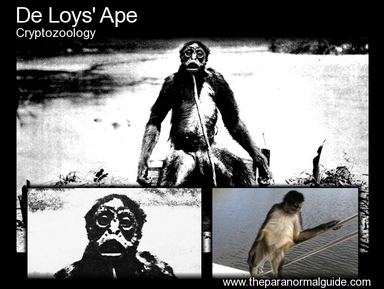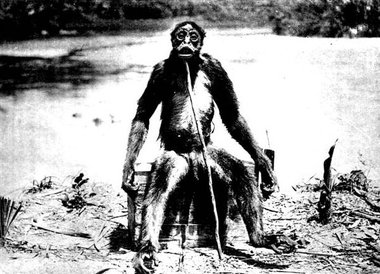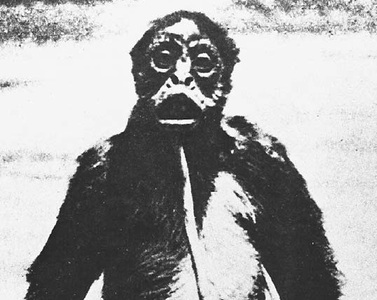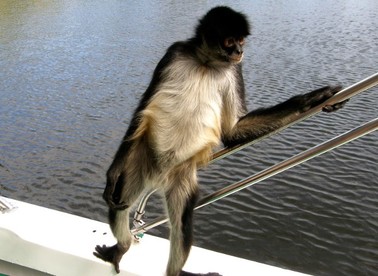
Many zoologists and cryptozoologists believe this creature to be a spider monkey, but others are not so sure.
A Strange Ape?
 Original image of the De Loys' Ape.
Original image of the De Loys' Ape. In the edition that hit newstands on the 15th June, 1929 it reported a story concerning a Swiss geologist by the name of François de Loys, who recounted a story about an expedition he and others had undertaken in South America over a decade earlier. During this expedition the group had been attacked by what De Loys claimed to be a large unknown species of primate.
The story was accompanied by a photograph, the only evidence besides his account of the incident. It showed what looked like a tall ape seated on a crate, with a large stick being used to prop up the creature by placing it under the creatures chin. De Loys had held onto this photograph and kept his story hidden for nine years until his friend, anthropologist George Montandon, had found the picture while searching through De Loys' files earlier that year and had convinced De Loys to tell his story.
While on expedition for three years, between 1917 and 1920, De Loys and nineteen other men searched the South American jungles for pertroleum. Near the end of the search, the group one night set camp near Lake Maracaibo, near the border of Colombia and Venezuela. Only four men at that point had survived the expedition, as disease and attacks by native tribes had killed the other sixteen by the last year.
 Close up of the face.
Close up of the face. The men examined the body, and were astonished to find they could not identify the creature. It looked like a spider monkey, however it was significantly taller than any known spider monkey species. It had 36 teeth, four more than the normal number sported by then-known monkey species. And it had no tail, according to De Loys, which stumped the men further. It was skinned,and its hide, jaw and skull were taken, however these were never found, as it has been claimed they were abandoned by the group before returning or were lost in transit.
The only evidence of the spectacular story was the single picture taken, however said picture did not clearly show the size of the creature. There have been claims more were taken but they too also disappeared.
Soon after the story was went public, George Montandon, who at the time was a renowned zoologist in France, proclaimed it to be an unknown species of ape, and gave it the scientific name Ameranthropoides loysi (or Loysi's Ape), after his friend and the man who had encountered and photographed it.
 A Spider Monkey, thought to be what the De Loys Ape could be.
A Spider Monkey, thought to be what the De Loys Ape could be. There are a few die-hard cryptozoologists that still maintain that the story and picture were factual, and represented something unknown that many in the scientific community were, and perhaps still are, unwilling or unable to accept as yet.
However, if De Loys was behind the hoax, why would a geologist, as his companions were being murdered or falling ill around him, enact such a fraud?
He apparently had little or no interest in zoology, and the supposed fact that he had kept the photograph hidden from the public for nearly a decade should say he was not seeking fame or fortune. So could the picture (and story) be real?





 RSS Feed
RSS Feed
